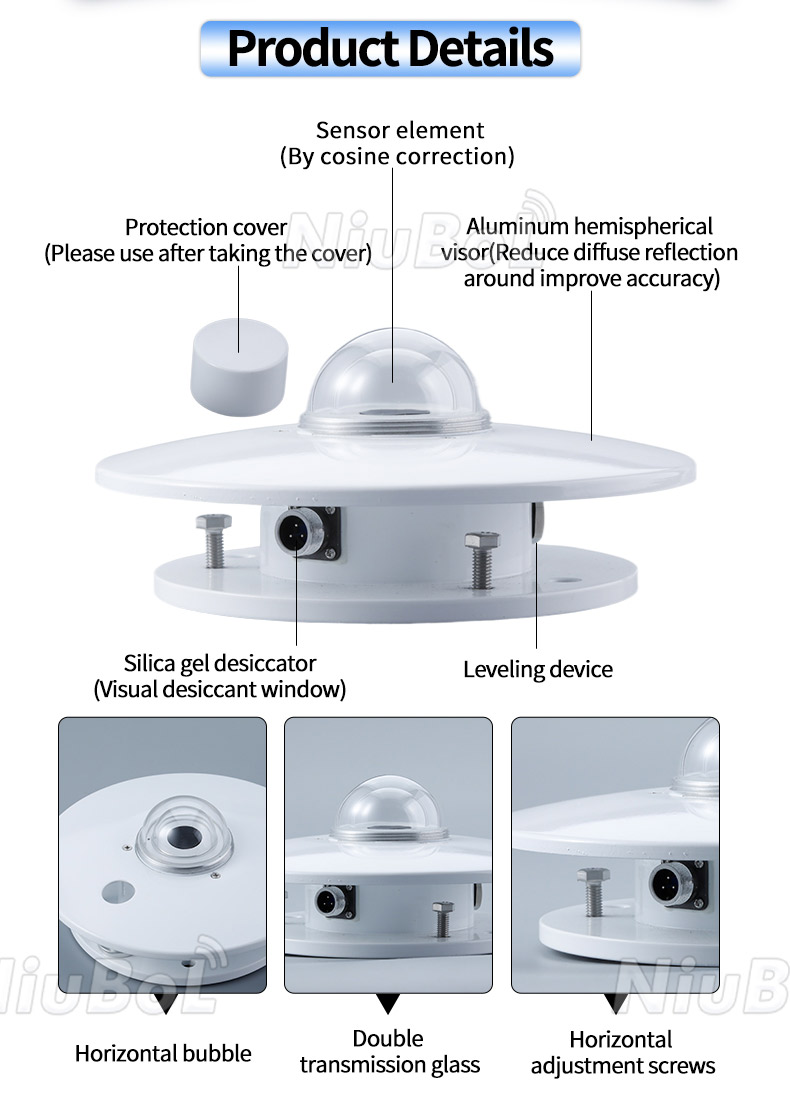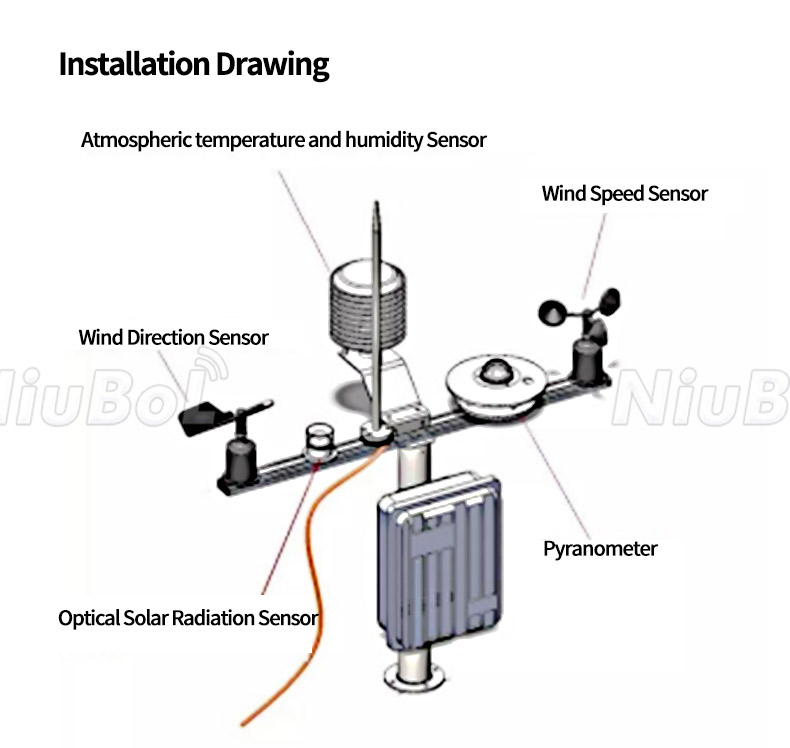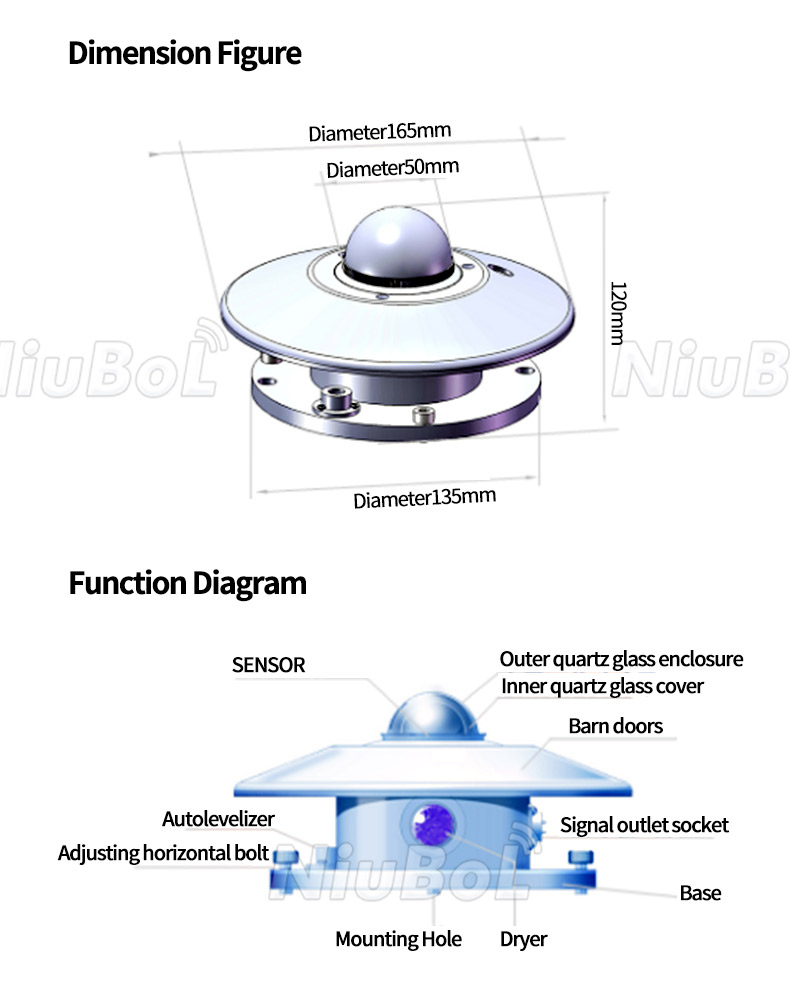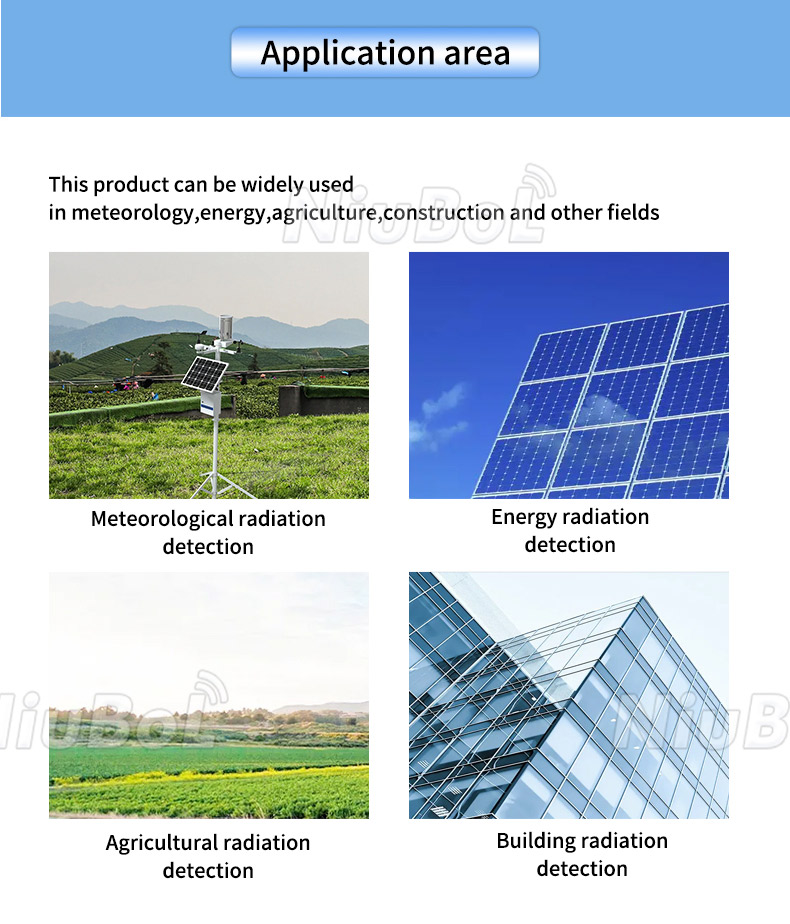

— Blogs —
—Products—
 Consumer hotline +8618073152920
Consumer hotline +8618073152920 WhatsApp:+8615367865107
Address:Room 102, District D, Houhu Industrial Park, Yuelu District, Changsha City, Hunan Province, China
Product knowledge
Time:2024-09-16 20:43:41 Popularity:1111
A pyranometer, also known as a solar intensity meter or total radiation meter or solar radiation sensor, is used to measure the intensity of solar radiation. A pyranometer is an instrument used to measure the total irradiance of the sun on a flat surface. The word “pyrometer” is derived from the Greek words “pyr” (fire) and “anemos” (wind), indicating that it measures the fire-like energy of the sun. The measurement range of a typical solar radiometer is designed to cover the full spectrum of solar radiation reaching the Earth's surface, including.
-Direct solar radiation (beam radiation)
-Diffuse solar radiation (scattered by the atmosphere)
-Reflected solar radiation (from the ground and other surfaces).
The pyranometer is widely used in meteorology, environmental monitoring, agriculture, aerospace, and solar energy research. Below is a detailed explanation of Pyranometer:

The pyranometer is a radiation measurement device based on the photoelectric effect principle, capable of measuring the solar radiation power received per unit area, usually in W/m². It measures not only direct radiation, but also scattered and reflected radiation, thus providing comprehensive solar radiation data.

The principle of operation of the Pyranometer relies mainly on the photoelectric effect. It usually consists of a photoreceptor, a photoconverter, a filter and other components. When solar radiation hits the photoreceptor, the photoreceptor absorbs photons and generates an electrical signal, which is then converted by the photoconverter into a measurable current or voltage value. A filter is used to select the appropriate spectral range to ensure the accuracy of the measurement results.

The measurement range of a pyranometer typically consists of two aspects: the wavelength range and the radiation intensity range.
In terms of wavelength, it focuses on the short-wave radiation of the sun, generally in the range of 300-3000nm. This wavelength range covers visible, ultraviolet and some infrared radiation, although some devices may cover a wider spectral range.
In terms of radiation intensity, it is capable of measuring total solar radiation in the range of around 0-2000W/m² or higher to accommodate higher irradiance levels that may occur in certain geographic locations or under certain atmospheric conditions, depending on the model and performance of the device.
It is important to note that actual measurement ranges may vary slightly from model to model and manufacturer to manufacturer, so it is always a good idea to check the specifications of the particular pyrometer you are using or considering purchasing.

The pyranometer has a wide range of applications in several fields:
1. Meteorological field: It is one of the necessary measuring equipment for weather stations, used to measure total solar radiation, ground radiation, air temperature, humidity and other meteorological parameters, providing important data support for weather forecasting and weather research.
2. Agricultural field: It is used to measure the total solar radiation received by crops as well as soil temperature, humidity and other parameters to help farmers make reasonable agricultural production plans and improve crop yield and quality.
3. Environmental monitoring field: used to monitor the total solar radiation and ground radiation and other parameters in cities, industrial zones, mining areas and other areas, as well as the photochemical reaction of atmospheric pollutants, etc., to provide reference data for environmental monitoring and air pollution control.
4. Aerospace field: It can be used on satellites, airplanes and other vehicles to measure parameters such as solar radiation in cosmic space and radiation in the atmosphere, providing important data for research in the aerospace field.

For example, the NBL-W-HPRS total radiation sensor produced by Niubol adopts the principle of thermoelectric induction, which can accurately measure the total radiation, reflected radiation, scattered radiation, infrared radiation, visible radiation, ultraviolet radiation and long-wave radiation from the sun, so the solar radiometer has a wide range of measurements, which can satisfy the needs of different fields for the measurement of solar radiation.
For example, in the field of environmental protection, solar radiometers can help scientists and engineers to carry out environmental monitoring and research; in the spacecraft, solar irradiation absolute radiometer can measure solar irradiance;
In the field of solar power generation, solar radiometers can provide critical meteorological data for evaluating the performance of solar power systems and optimizing system design. In short, solar radiometers have a wide range of measurements and can meet the needs of different fields for solar radiation measurement.
As technology continues to advance and the demand for solar radiation data in various fields increases, the Pyranometer's technology continues to evolve. In the future, the Pyranometer will pay more attention to improve the accuracy and stability of the measurement, and at the same time expand its application areas to realize the application of multi-parameter measurement and wireless transmission technology. This will help to better meet the demand for solar radiation data in various fields and promote the development and progress of related fields.
NBL-W-HPRS-Solar-Radiation-Sensor-Instruction-Manual-V3.0.pdf
Prev:What are the advantages of a pyranometer?
Next:What is difference between soil moisture sensor and relative humidity sensor?
Related recommendations
Sensors & Weather Stations Catalog
Agriculture Sensors and Weather Stations Catalog-NiuBoL.pdf
Weather Stations Catalog-NiuBoL.pdf
Related products
 Combined air temperature and relative humidity sensor
Combined air temperature and relative humidity sensor Soil Moisture Temperature sensor for irrigation
Soil Moisture Temperature sensor for irrigation Soil pH sensor RS485 soil Testing instrument soil ph meter for agriculture
Soil pH sensor RS485 soil Testing instrument soil ph meter for agriculture Wind Speed sensor Output Modbus/RS485/Analog/0-5V/4-20mA
Wind Speed sensor Output Modbus/RS485/Analog/0-5V/4-20mA Tipping bucket rain gauge for weather monitoring auto rainfall sensor RS485/Outdoor/stainless steel
Tipping bucket rain gauge for weather monitoring auto rainfall sensor RS485/Outdoor/stainless steel Pyranometer Solar Radiation Sensor 4-20mA/RS485
Pyranometer Solar Radiation Sensor 4-20mA/RS485
Screenshot, WhatsApp to identify the QR code
WhatsApp number:+8615367865107
(Click on WhatsApp to copy and add friends)
